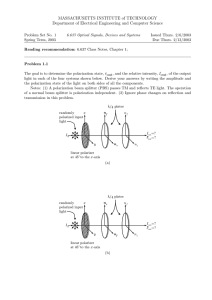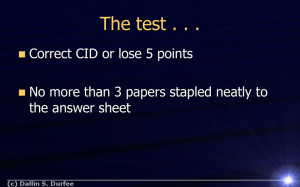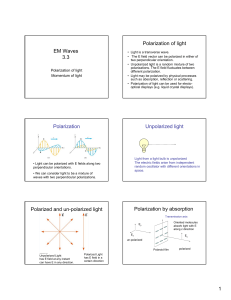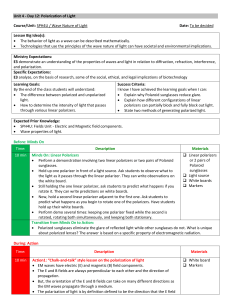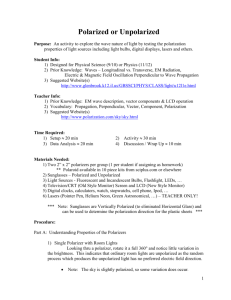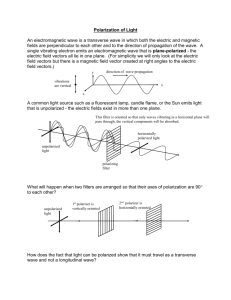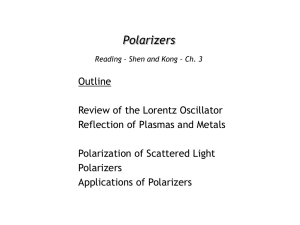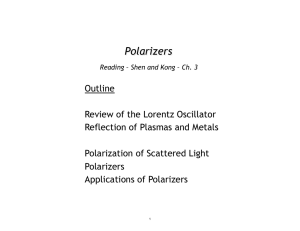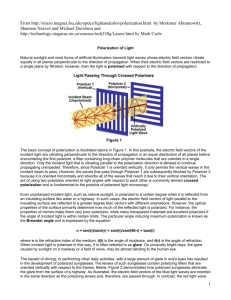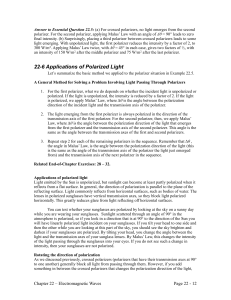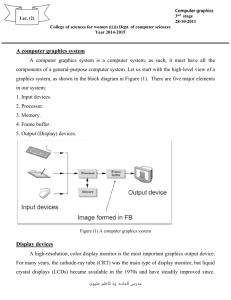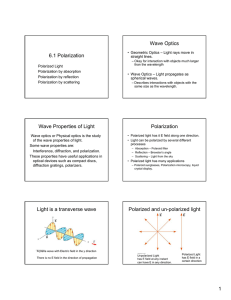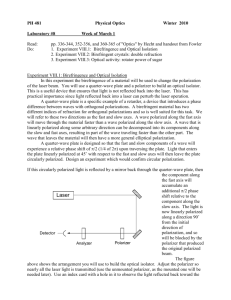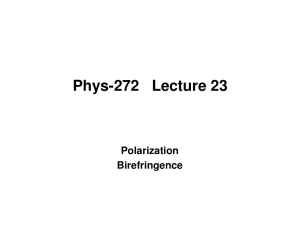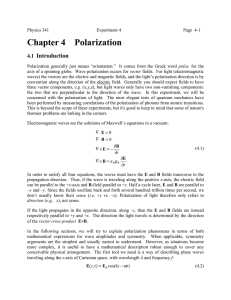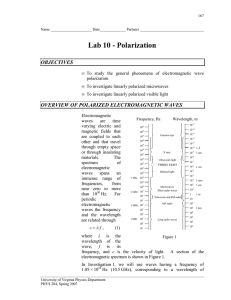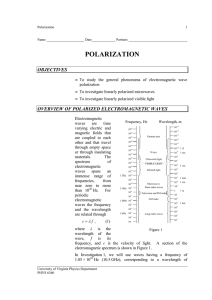polarization nm
advertisement
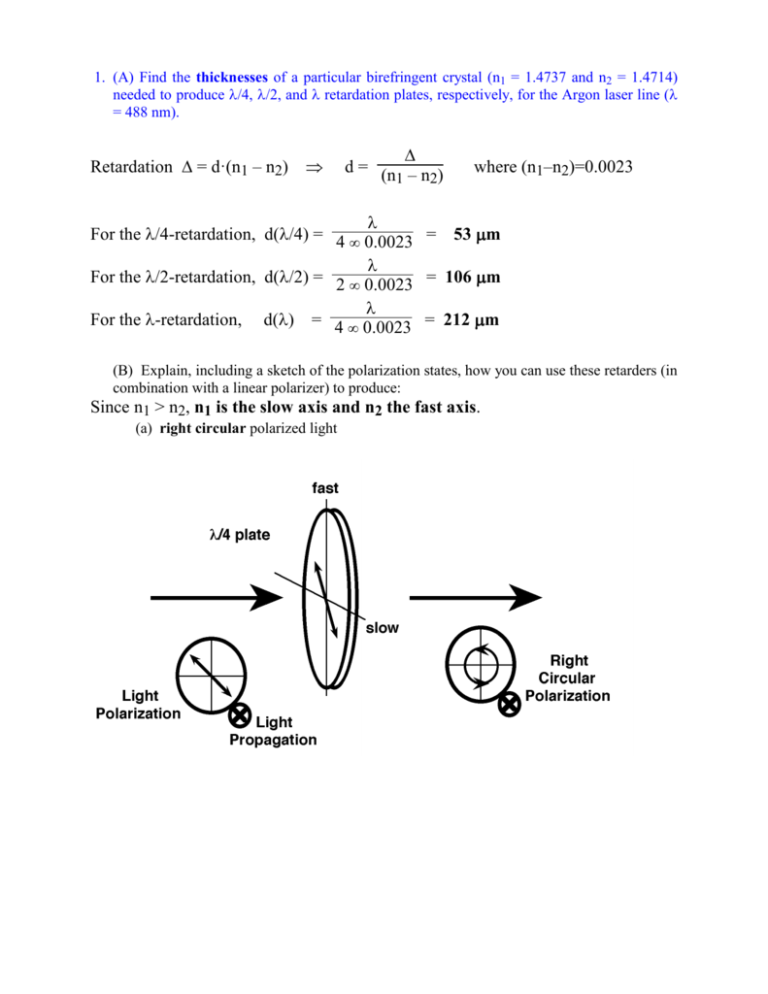
1. (A) Find the thicknesses of a particular birefringent crystal (n1 = 1.4737 and n2 = 1.4714) needed to produce /4, /2, and retardation plates, respectively, for the Argon laser line ( = 488 nm). Retardation = d·(n1 – n2) d = (n – n ) 1 2 where (n1–n2)=0.0023 For the /4-retardation, d(/4) = 4 0.0023 = 53 m For the /2-retardation, d(/2) = 2 0.0023 = 106 m For the -retardation, d() = 4 0.0023 = 212 m (B) Explain, including a sketch of the polarization states, how you can use these retarders (in combination with a linear polarizer) to produce: Since n1 > n2, n1 is the slow axis and n2 the fast axis. (a) right circular polarized light (b) left circular polarized light (c) 90° rotation of plane-polarized light fast /2 plate slow Light Polarization 90° Rotation of Linear Polarization Light Propagation (C) How do you produce with the help of the above mentioned optical elements elliptically polarized light? (Explain and make a sketch.) 2. You are working with a linearly polarized laser which emits a beam of light both at 1 = 700 nm and 2 = 450 nm wavelengths, and you have available material of linear birefringence with nx = 1.7735 and ny = 1.7719. You want to design and cut it with a proper thickness which can be used simultaneously as a circular polarizer for 1, and which changes the linear polarization of 2 into 90° crossed linear polarization. (A) What is the thickness of your chosen plate? We need a retarder which can be a quater-plate for 1 and a half-plate for 2 simultaneously. m1 1 1 Retardation = d· (nx – ny) = 2 1 + 4 1 = m2 2 + 2 2 where m1 and m2 must be integers. 1 1 (2m + 1) = 1 1 4 2 2 (m2 + 1) 2m1 + 1 2 / 2 225 9 = = = 2m2 + 1 175 7 1 / 4 Therefore, (m1, m2) = (4,3) or (13,10) or (22,17) or (31,24) or .... (4+9n,3+7n) .. We choose the set of the smallest numbers, m1 = 4 and m2 = 3. Then, 9 7 1.575 m = 4 1 = 2 2 = 1.575 m d = 0.0016 = 984 m (B) Show in a sketch how you arrange the laser and its polarization relative to the retardation plate, and indicate the achieved polarizations for the two wave lengths behind the plate. 1 fast Right Circular Polarization 2 Light Polarization slow 90° Rotation of Linear Polarization Light Propagation 3. You want to distinguish experimentally unpolarized from circularly polarized light of the same wavelength . Describe the procedures in words and sketches. (A) What physical tools will you need to do this and how will you arrange and use them? We need two tools which are one /4-retarder and one linear polarizer. When the circular polarized light goes through the /4-retarder, it will become a linear polarized light which can be easily detected by a linear polarizer. When the unpolarized light goes through the /4-retarder, however, it is still the unpolarized light. Its intensity will not be changed under the rotation of the linear polarizer. Unpolarized Light /4 retarder Unpolarized Light fast Linear Polarizer Under Turning No Intensity Change slow Intensity Change Circular Polarized Light Linear Polarized Light (B) How will you determine if a circularly polarized light is left-circular or right-circular? We have to know the fast- and slow-axis of the /4-retarder, and the transmissionaxis of linear polarizer. See the following sketch. /4 retarder Linear Polarizer f fast Right Circular Polarized s slow Left Circular Polalrized f s Linear Polarized Light Testing the linear polarized direction relative to the fast- or slow-axis as shown in this figure. Problem 4: (a) If you have two polarizers in crossed position and put one in between you will get some light through again. Why ? (b) How would you need to position 8 additional polarizers between two crossed polarizers to obtain maximum transmission. (a) just use Malus Law. The additional polarizer will reduce the intensity according to Malus law and turn the polarization into its axis. This polarization is only reducd but not completely blocked by the final polarizers (b) For 8 additional polarizers you need to position one of an other rotated by an angle of 90/(8+1) relative to the previous polarizer



